Fiscal Policy of the Australian Government in the Last 3-5 Years
VerifiedAdded on 2020/04/07
|15
|4110
|40
Essay
AI Summary
This essay provides a comprehensive analysis of the fiscal policies implemented by the Australian government over the last three to five years. It begins with an introduction to the Australian economy, highlighting its developed mixed economy status and long-running economic growth, and then defines fiscal policy as a key tool for government control over the economy, contrasting it with monetary policy. The essay explores the evolution of fiscal policy, from laissez-faire approaches to Keynesian economics, and details the two main types of fiscal policy: expansionary and contractionary. The core of the essay focuses on the application of fiscal policy in Australia, emphasizing its mixed tax system, medium-term framework for budget balance, and strategies for budget repair. It examines the government's objectives of economic stabilization and long-term growth, including the use of counter-cyclical fiscal policies. The essay discusses the government's Ten Year Enterprise Tax Plan and the instruments used in fiscal policy, such as government investments, taxes, and borrowings, and it concludes by highlighting the role of fiscal policy in stabilizing economic fluctuations and promoting sustainable economic growth.

Running head: FISCAL POLICY OF AUSTRALIAN GOVERNMENT
Fiscal Policy of Australian government in last 3 to 5 years
Name of the Student:
Name of the University:
Author note:
Fiscal Policy of Australian government in last 3 to 5 years
Name of the Student:
Name of the University:
Author note:
Paraphrase This Document
Need a fresh take? Get an instant paraphrase of this document with our AI Paraphraser

1FISCAL POLICY OF AUSTRALIAN GOVERNMENT
Introduction
Australia is considered as one of the most developed and biggest mixed economies of the
world. In 2017, the GDP of Australia was AUD 1.69 trillion. The country holds the second
position in the ranks of wealthiest country in terms of wealth per adult. Australia holds the record
of having longest running economic growth for more than 26 years (Li and Spencer 2016). In
other words, for more than two decades, the country never faced recession. The term ‘Recession’
is explained as two successive quarters of negative economic growth. It has been a remarkable
success for the economy to achieve such a longest period of growth. Economic policies of the
government played a crucial role in this remarkable performance of the Australian economy
(Fazzari, Morley and Panovska 2015).
Monetary as well as fiscal policy contributes in economic growth. The government
makes policies to control the money supply in the economy and also determines the level of
government expenditure to push forward the economy. However, one view says that fiscal policy
can stifle the economic growth through the distortionary impacts of taxation and ineffective
government spending. On the other hand, government plays a critical part in economic
development through the provision of infrastructure and public goods. Hence, the government
policies have both the positive and negative impacts on economic growth (Wanna, Lindquist and
De Vries 2015).
The taxation system of Australia is quite improved. It is levied at the local, state and
federal government levels. The federal government of Australia collects the revenue from
business and personal income taxes. The other types of taxes are goods and services tax or
General Services Tax (Corsetti et al. 2013). The following report/essay focuses on the fiscal
Introduction
Australia is considered as one of the most developed and biggest mixed economies of the
world. In 2017, the GDP of Australia was AUD 1.69 trillion. The country holds the second
position in the ranks of wealthiest country in terms of wealth per adult. Australia holds the record
of having longest running economic growth for more than 26 years (Li and Spencer 2016). In
other words, for more than two decades, the country never faced recession. The term ‘Recession’
is explained as two successive quarters of negative economic growth. It has been a remarkable
success for the economy to achieve such a longest period of growth. Economic policies of the
government played a crucial role in this remarkable performance of the Australian economy
(Fazzari, Morley and Panovska 2015).
Monetary as well as fiscal policy contributes in economic growth. The government
makes policies to control the money supply in the economy and also determines the level of
government expenditure to push forward the economy. However, one view says that fiscal policy
can stifle the economic growth through the distortionary impacts of taxation and ineffective
government spending. On the other hand, government plays a critical part in economic
development through the provision of infrastructure and public goods. Hence, the government
policies have both the positive and negative impacts on economic growth (Wanna, Lindquist and
De Vries 2015).
The taxation system of Australia is quite improved. It is levied at the local, state and
federal government levels. The federal government of Australia collects the revenue from
business and personal income taxes. The other types of taxes are goods and services tax or
General Services Tax (Corsetti et al. 2013). The following report/essay focuses on the fiscal
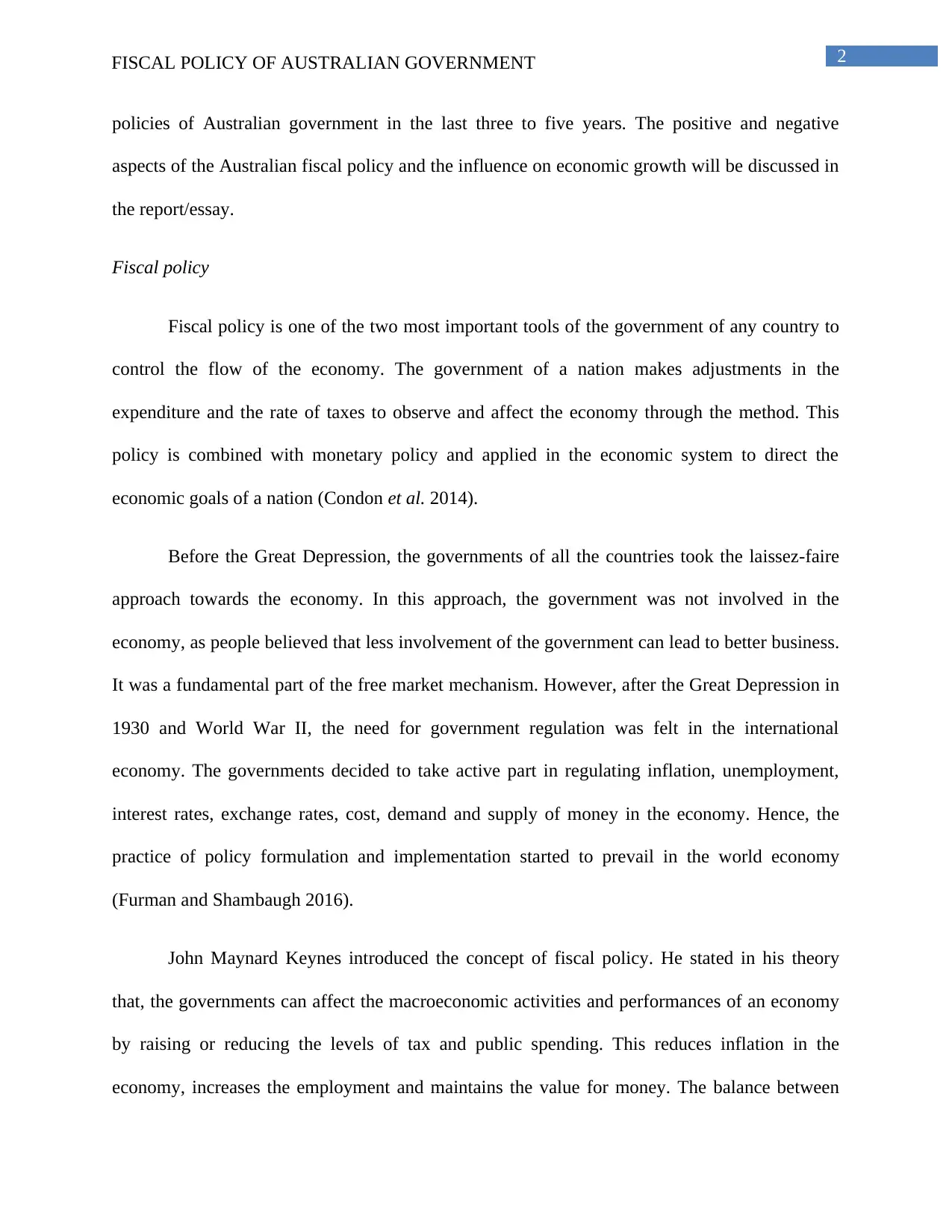
2FISCAL POLICY OF AUSTRALIAN GOVERNMENT
policies of Australian government in the last three to five years. The positive and negative
aspects of the Australian fiscal policy and the influence on economic growth will be discussed in
the report/essay.
Fiscal policy
Fiscal policy is one of the two most important tools of the government of any country to
control the flow of the economy. The government of a nation makes adjustments in the
expenditure and the rate of taxes to observe and affect the economy through the method. This
policy is combined with monetary policy and applied in the economic system to direct the
economic goals of a nation (Condon et al. 2014).
Before the Great Depression, the governments of all the countries took the laissez-faire
approach towards the economy. In this approach, the government was not involved in the
economy, as people believed that less involvement of the government can lead to better business.
It was a fundamental part of the free market mechanism. However, after the Great Depression in
1930 and World War II, the need for government regulation was felt in the international
economy. The governments decided to take active part in regulating inflation, unemployment,
interest rates, exchange rates, cost, demand and supply of money in the economy. Hence, the
practice of policy formulation and implementation started to prevail in the world economy
(Furman and Shambaugh 2016).
John Maynard Keynes introduced the concept of fiscal policy. He stated in his theory
that, the governments can affect the macroeconomic activities and performances of an economy
by raising or reducing the levels of tax and public spending. This reduces inflation in the
economy, increases the employment and maintains the value for money. The balance between
policies of Australian government in the last three to five years. The positive and negative
aspects of the Australian fiscal policy and the influence on economic growth will be discussed in
the report/essay.
Fiscal policy
Fiscal policy is one of the two most important tools of the government of any country to
control the flow of the economy. The government of a nation makes adjustments in the
expenditure and the rate of taxes to observe and affect the economy through the method. This
policy is combined with monetary policy and applied in the economic system to direct the
economic goals of a nation (Condon et al. 2014).
Before the Great Depression, the governments of all the countries took the laissez-faire
approach towards the economy. In this approach, the government was not involved in the
economy, as people believed that less involvement of the government can lead to better business.
It was a fundamental part of the free market mechanism. However, after the Great Depression in
1930 and World War II, the need for government regulation was felt in the international
economy. The governments decided to take active part in regulating inflation, unemployment,
interest rates, exchange rates, cost, demand and supply of money in the economy. Hence, the
practice of policy formulation and implementation started to prevail in the world economy
(Furman and Shambaugh 2016).
John Maynard Keynes introduced the concept of fiscal policy. He stated in his theory
that, the governments can affect the macroeconomic activities and performances of an economy
by raising or reducing the levels of tax and public spending. This reduces inflation in the
economy, increases the employment and maintains the value for money. The balance between
⊘ This is a preview!⊘
Do you want full access?
Subscribe today to unlock all pages.

Trusted by 1+ million students worldwide
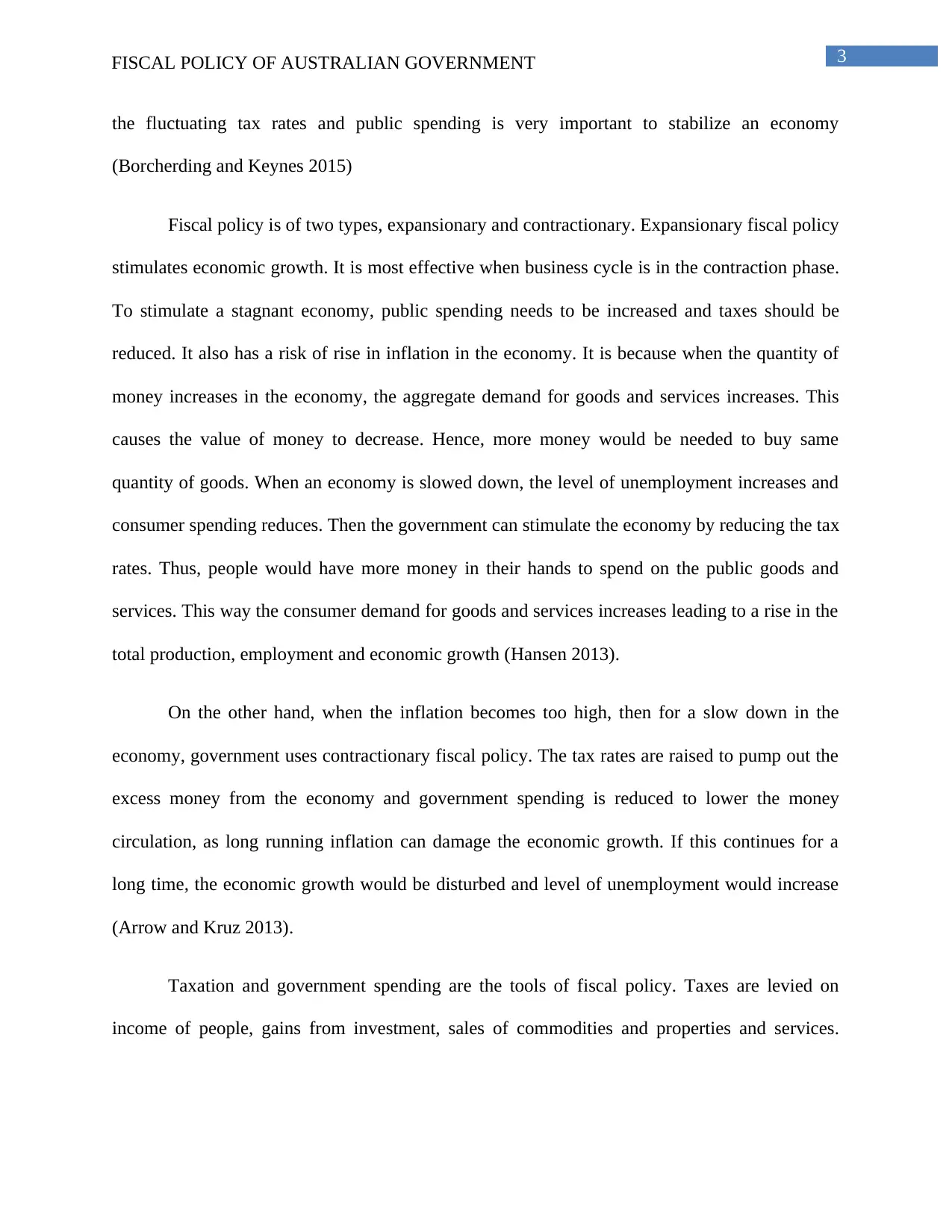
3FISCAL POLICY OF AUSTRALIAN GOVERNMENT
the fluctuating tax rates and public spending is very important to stabilize an economy
(Borcherding and Keynes 2015)
Fiscal policy is of two types, expansionary and contractionary. Expansionary fiscal policy
stimulates economic growth. It is most effective when business cycle is in the contraction phase.
To stimulate a stagnant economy, public spending needs to be increased and taxes should be
reduced. It also has a risk of rise in inflation in the economy. It is because when the quantity of
money increases in the economy, the aggregate demand for goods and services increases. This
causes the value of money to decrease. Hence, more money would be needed to buy same
quantity of goods. When an economy is slowed down, the level of unemployment increases and
consumer spending reduces. Then the government can stimulate the economy by reducing the tax
rates. Thus, people would have more money in their hands to spend on the public goods and
services. This way the consumer demand for goods and services increases leading to a rise in the
total production, employment and economic growth (Hansen 2013).
On the other hand, when the inflation becomes too high, then for a slow down in the
economy, government uses contractionary fiscal policy. The tax rates are raised to pump out the
excess money from the economy and government spending is reduced to lower the money
circulation, as long running inflation can damage the economic growth. If this continues for a
long time, the economic growth would be disturbed and level of unemployment would increase
(Arrow and Kruz 2013).
Taxation and government spending are the tools of fiscal policy. Taxes are levied on
income of people, gains from investment, sales of commodities and properties and services.
the fluctuating tax rates and public spending is very important to stabilize an economy
(Borcherding and Keynes 2015)
Fiscal policy is of two types, expansionary and contractionary. Expansionary fiscal policy
stimulates economic growth. It is most effective when business cycle is in the contraction phase.
To stimulate a stagnant economy, public spending needs to be increased and taxes should be
reduced. It also has a risk of rise in inflation in the economy. It is because when the quantity of
money increases in the economy, the aggregate demand for goods and services increases. This
causes the value of money to decrease. Hence, more money would be needed to buy same
quantity of goods. When an economy is slowed down, the level of unemployment increases and
consumer spending reduces. Then the government can stimulate the economy by reducing the tax
rates. Thus, people would have more money in their hands to spend on the public goods and
services. This way the consumer demand for goods and services increases leading to a rise in the
total production, employment and economic growth (Hansen 2013).
On the other hand, when the inflation becomes too high, then for a slow down in the
economy, government uses contractionary fiscal policy. The tax rates are raised to pump out the
excess money from the economy and government spending is reduced to lower the money
circulation, as long running inflation can damage the economic growth. If this continues for a
long time, the economic growth would be disturbed and level of unemployment would increase
(Arrow and Kruz 2013).
Taxation and government spending are the tools of fiscal policy. Taxes are levied on
income of people, gains from investment, sales of commodities and properties and services.
Paraphrase This Document
Need a fresh take? Get an instant paraphrase of this document with our AI Paraphraser
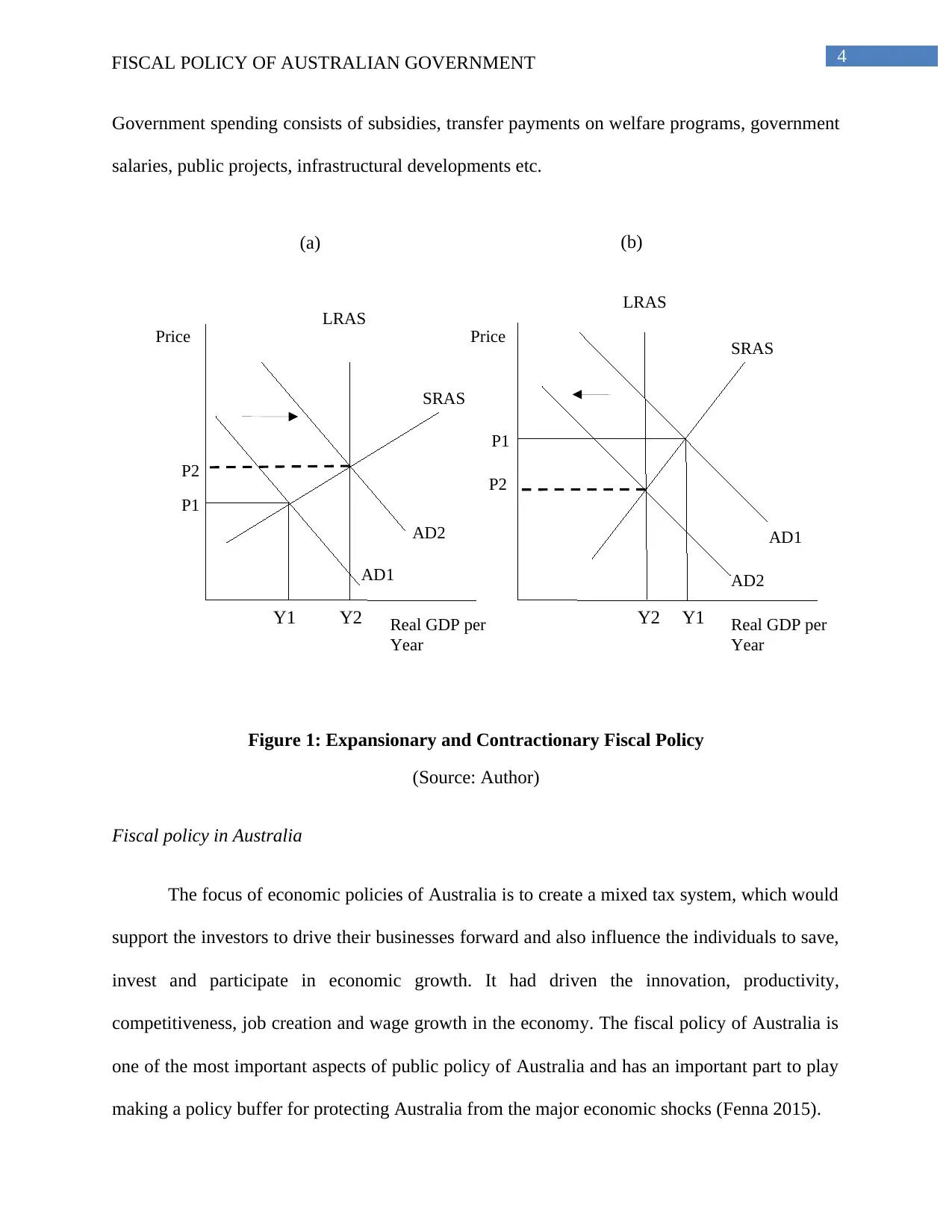
4FISCAL POLICY OF AUSTRALIAN GOVERNMENT
(a) (b)
LRAS
LRAS
SRAS
SRAS
AD1
AD1
AD2
AD2
P1
P1
P2 P2
Price Price
Real GDP per
Year
Real GDP per
Year
Y1 Y1Y2 Y2
Government spending consists of subsidies, transfer payments on welfare programs, government
salaries, public projects, infrastructural developments etc.
Figure 1: Expansionary and Contractionary Fiscal Policy
(Source: Author)
Fiscal policy in Australia
The focus of economic policies of Australia is to create a mixed tax system, which would
support the investors to drive their businesses forward and also influence the individuals to save,
invest and participate in economic growth. It had driven the innovation, productivity,
competitiveness, job creation and wage growth in the economy. The fiscal policy of Australia is
one of the most important aspects of public policy of Australia and has an important part to play
making a policy buffer for protecting Australia from the major economic shocks (Fenna 2015).
(a) (b)
LRAS
LRAS
SRAS
SRAS
AD1
AD1
AD2
AD2
P1
P1
P2 P2
Price Price
Real GDP per
Year
Real GDP per
Year
Y1 Y1Y2 Y2
Government spending consists of subsidies, transfer payments on welfare programs, government
salaries, public projects, infrastructural developments etc.
Figure 1: Expansionary and Contractionary Fiscal Policy
(Source: Author)
Fiscal policy in Australia
The focus of economic policies of Australia is to create a mixed tax system, which would
support the investors to drive their businesses forward and also influence the individuals to save,
invest and participate in economic growth. It had driven the innovation, productivity,
competitiveness, job creation and wage growth in the economy. The fiscal policy of Australia is
one of the most important aspects of public policy of Australia and has an important part to play
making a policy buffer for protecting Australia from the major economic shocks (Fenna 2015).
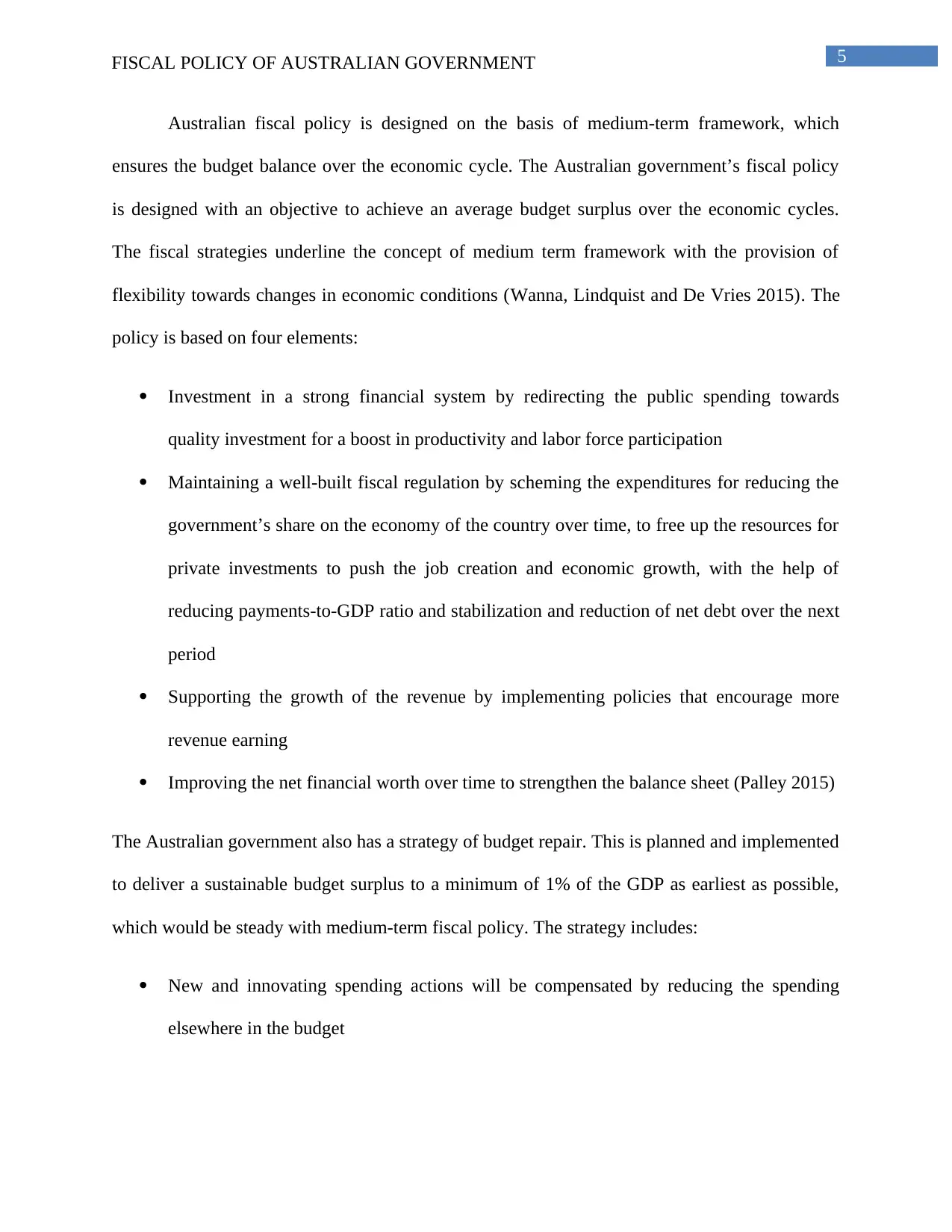
5FISCAL POLICY OF AUSTRALIAN GOVERNMENT
Australian fiscal policy is designed on the basis of medium-term framework, which
ensures the budget balance over the economic cycle. The Australian government’s fiscal policy
is designed with an objective to achieve an average budget surplus over the economic cycles.
The fiscal strategies underline the concept of medium term framework with the provision of
flexibility towards changes in economic conditions (Wanna, Lindquist and De Vries 2015). The
policy is based on four elements:
Investment in a strong financial system by redirecting the public spending towards
quality investment for a boost in productivity and labor force participation
Maintaining a well-built fiscal regulation by scheming the expenditures for reducing the
government’s share on the economy of the country over time, to free up the resources for
private investments to push the job creation and economic growth, with the help of
reducing payments-to-GDP ratio and stabilization and reduction of net debt over the next
period
Supporting the growth of the revenue by implementing policies that encourage more
revenue earning
Improving the net financial worth over time to strengthen the balance sheet (Palley 2015)
The Australian government also has a strategy of budget repair. This is planned and implemented
to deliver a sustainable budget surplus to a minimum of 1% of the GDP as earliest as possible,
which would be steady with medium-term fiscal policy. The strategy includes:
New and innovating spending actions will be compensated by reducing the spending
elsewhere in the budget
Australian fiscal policy is designed on the basis of medium-term framework, which
ensures the budget balance over the economic cycle. The Australian government’s fiscal policy
is designed with an objective to achieve an average budget surplus over the economic cycles.
The fiscal strategies underline the concept of medium term framework with the provision of
flexibility towards changes in economic conditions (Wanna, Lindquist and De Vries 2015). The
policy is based on four elements:
Investment in a strong financial system by redirecting the public spending towards
quality investment for a boost in productivity and labor force participation
Maintaining a well-built fiscal regulation by scheming the expenditures for reducing the
government’s share on the economy of the country over time, to free up the resources for
private investments to push the job creation and economic growth, with the help of
reducing payments-to-GDP ratio and stabilization and reduction of net debt over the next
period
Supporting the growth of the revenue by implementing policies that encourage more
revenue earning
Improving the net financial worth over time to strengthen the balance sheet (Palley 2015)
The Australian government also has a strategy of budget repair. This is planned and implemented
to deliver a sustainable budget surplus to a minimum of 1% of the GDP as earliest as possible,
which would be steady with medium-term fiscal policy. The strategy includes:
New and innovating spending actions will be compensated by reducing the spending
elsewhere in the budget
⊘ This is a preview!⊘
Do you want full access?
Subscribe today to unlock all pages.

Trusted by 1+ million students worldwide
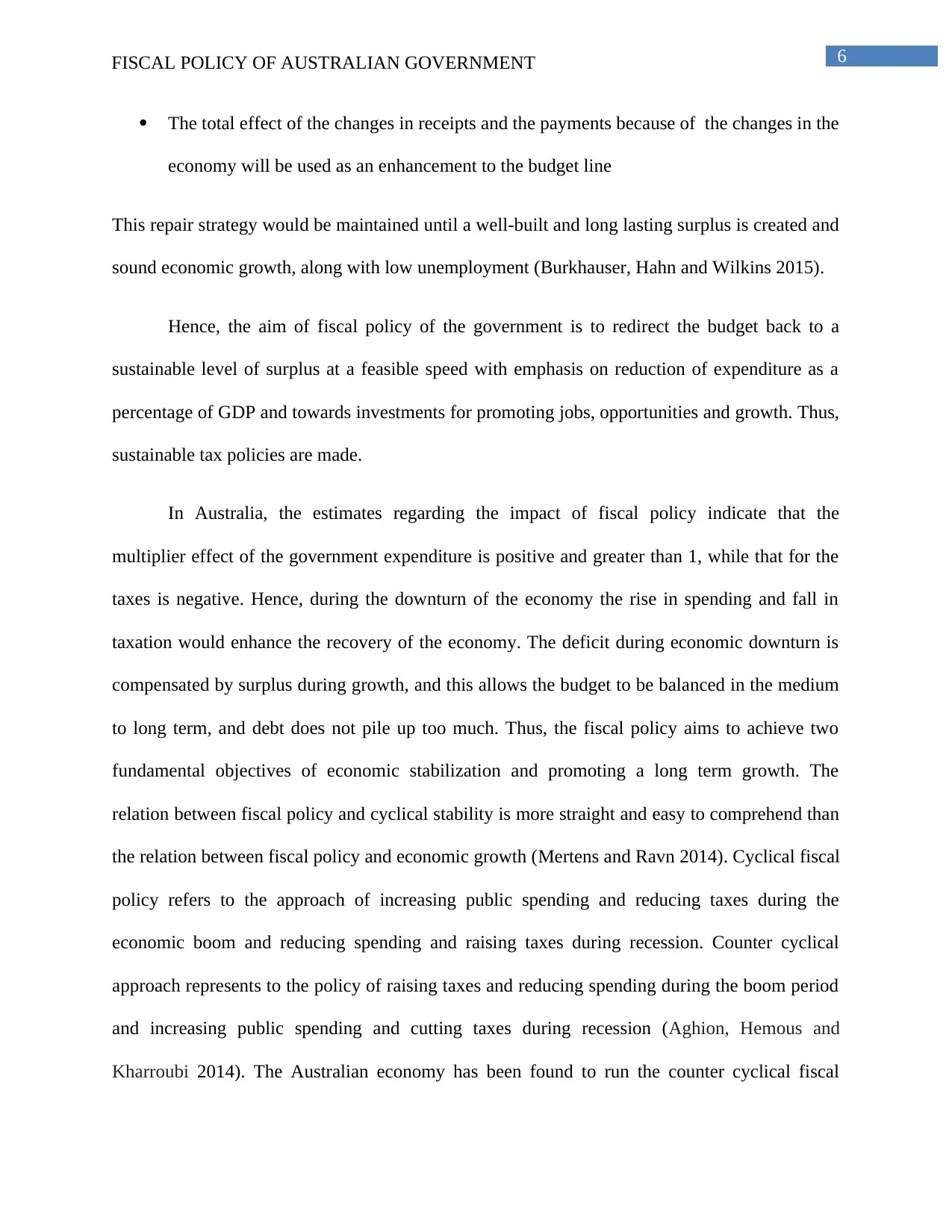
6FISCAL POLICY OF AUSTRALIAN GOVERNMENT
The total effect of the changes in receipts and the payments because of the changes in the
economy will be used as an enhancement to the budget line
This repair strategy would be maintained until a well-built and long lasting surplus is created and
sound economic growth, along with low unemployment (Burkhauser, Hahn and Wilkins 2015).
Hence, the aim of fiscal policy of the government is to redirect the budget back to a
sustainable level of surplus at a feasible speed with emphasis on reduction of expenditure as a
percentage of GDP and towards investments for promoting jobs, opportunities and growth. Thus,
sustainable tax policies are made.
In Australia, the estimates regarding the impact of fiscal policy indicate that the
multiplier effect of the government expenditure is positive and greater than 1, while that for the
taxes is negative. Hence, during the downturn of the economy the rise in spending and fall in
taxation would enhance the recovery of the economy. The deficit during economic downturn is
compensated by surplus during growth, and this allows the budget to be balanced in the medium
to long term, and debt does not pile up too much. Thus, the fiscal policy aims to achieve two
fundamental objectives of economic stabilization and promoting a long term growth. The
relation between fiscal policy and cyclical stability is more straight and easy to comprehend than
the relation between fiscal policy and economic growth (Mertens and Ravn 2014). Cyclical fiscal
policy refers to the approach of increasing public spending and reducing taxes during the
economic boom and reducing spending and raising taxes during recession. Counter cyclical
approach represents to the policy of raising taxes and reducing spending during the boom period
and increasing public spending and cutting taxes during recession (Aghion, Hemous and
Kharroubi 2014). The Australian economy has been found to run the counter cyclical fiscal
The total effect of the changes in receipts and the payments because of the changes in the
economy will be used as an enhancement to the budget line
This repair strategy would be maintained until a well-built and long lasting surplus is created and
sound economic growth, along with low unemployment (Burkhauser, Hahn and Wilkins 2015).
Hence, the aim of fiscal policy of the government is to redirect the budget back to a
sustainable level of surplus at a feasible speed with emphasis on reduction of expenditure as a
percentage of GDP and towards investments for promoting jobs, opportunities and growth. Thus,
sustainable tax policies are made.
In Australia, the estimates regarding the impact of fiscal policy indicate that the
multiplier effect of the government expenditure is positive and greater than 1, while that for the
taxes is negative. Hence, during the downturn of the economy the rise in spending and fall in
taxation would enhance the recovery of the economy. The deficit during economic downturn is
compensated by surplus during growth, and this allows the budget to be balanced in the medium
to long term, and debt does not pile up too much. Thus, the fiscal policy aims to achieve two
fundamental objectives of economic stabilization and promoting a long term growth. The
relation between fiscal policy and cyclical stability is more straight and easy to comprehend than
the relation between fiscal policy and economic growth (Mertens and Ravn 2014). Cyclical fiscal
policy refers to the approach of increasing public spending and reducing taxes during the
economic boom and reducing spending and raising taxes during recession. Counter cyclical
approach represents to the policy of raising taxes and reducing spending during the boom period
and increasing public spending and cutting taxes during recession (Aghion, Hemous and
Kharroubi 2014). The Australian economy has been found to run the counter cyclical fiscal
Paraphrase This Document
Need a fresh take? Get an instant paraphrase of this document with our AI Paraphraser
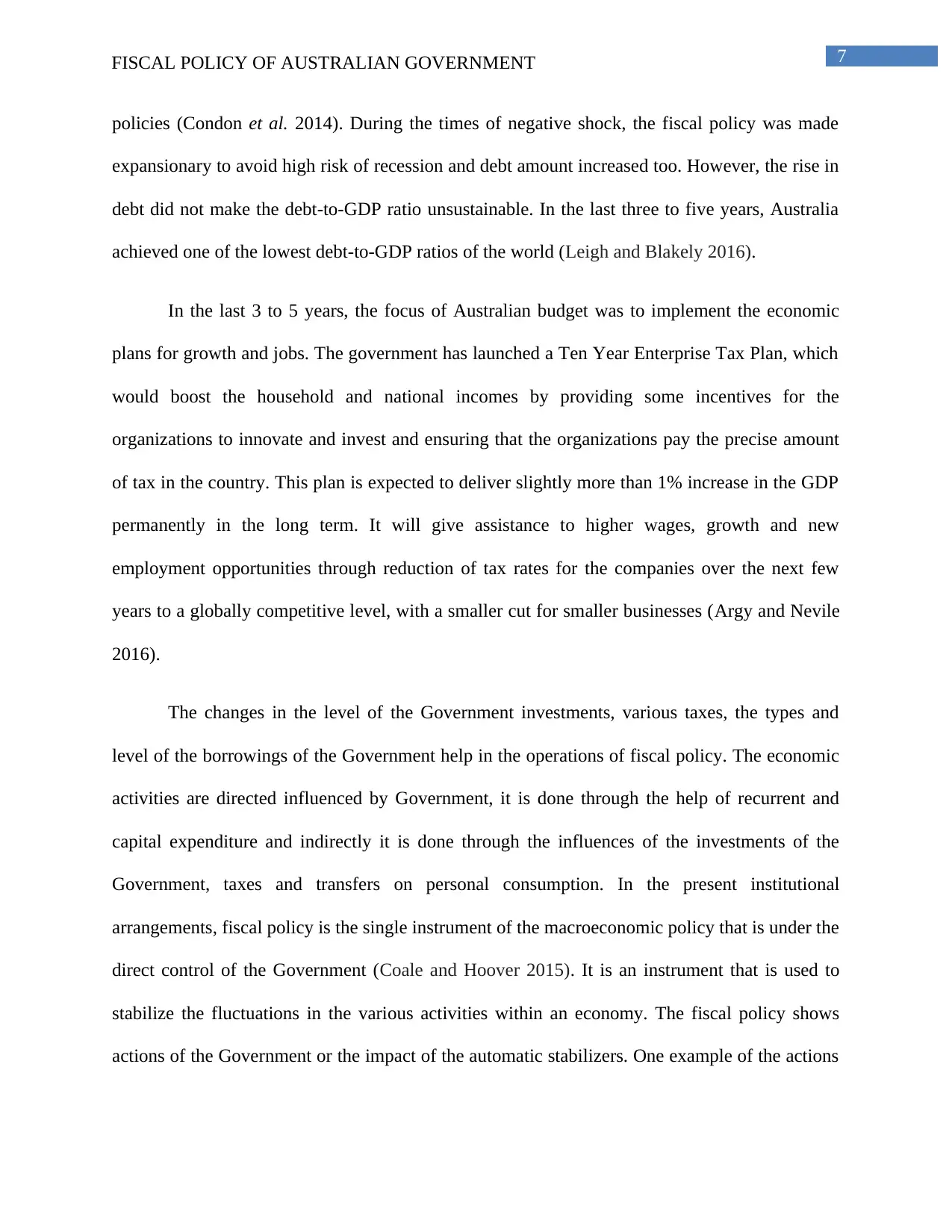
7FISCAL POLICY OF AUSTRALIAN GOVERNMENT
policies (Condon et al. 2014). During the times of negative shock, the fiscal policy was made
expansionary to avoid high risk of recession and debt amount increased too. However, the rise in
debt did not make the debt-to-GDP ratio unsustainable. In the last three to five years, Australia
achieved one of the lowest debt-to-GDP ratios of the world (Leigh and Blakely 2016).
In the last 3 to 5 years, the focus of Australian budget was to implement the economic
plans for growth and jobs. The government has launched a Ten Year Enterprise Tax Plan, which
would boost the household and national incomes by providing some incentives for the
organizations to innovate and invest and ensuring that the organizations pay the precise amount
of tax in the country. This plan is expected to deliver slightly more than 1% increase in the GDP
permanently in the long term. It will give assistance to higher wages, growth and new
employment opportunities through reduction of tax rates for the companies over the next few
years to a globally competitive level, with a smaller cut for smaller businesses (Argy and Nevile
2016).
The changes in the level of the Government investments, various taxes, the types and
level of the borrowings of the Government help in the operations of fiscal policy. The economic
activities are directed influenced by Government, it is done through the help of recurrent and
capital expenditure and indirectly it is done through the influences of the investments of the
Government, taxes and transfers on personal consumption. In the present institutional
arrangements, fiscal policy is the single instrument of the macroeconomic policy that is under the
direct control of the Government (Coale and Hoover 2015). It is an instrument that is used to
stabilize the fluctuations in the various activities within an economy. The fiscal policy shows
actions of the Government or the impact of the automatic stabilizers. One example of the actions
policies (Condon et al. 2014). During the times of negative shock, the fiscal policy was made
expansionary to avoid high risk of recession and debt amount increased too. However, the rise in
debt did not make the debt-to-GDP ratio unsustainable. In the last three to five years, Australia
achieved one of the lowest debt-to-GDP ratios of the world (Leigh and Blakely 2016).
In the last 3 to 5 years, the focus of Australian budget was to implement the economic
plans for growth and jobs. The government has launched a Ten Year Enterprise Tax Plan, which
would boost the household and national incomes by providing some incentives for the
organizations to innovate and invest and ensuring that the organizations pay the precise amount
of tax in the country. This plan is expected to deliver slightly more than 1% increase in the GDP
permanently in the long term. It will give assistance to higher wages, growth and new
employment opportunities through reduction of tax rates for the companies over the next few
years to a globally competitive level, with a smaller cut for smaller businesses (Argy and Nevile
2016).
The changes in the level of the Government investments, various taxes, the types and
level of the borrowings of the Government help in the operations of fiscal policy. The economic
activities are directed influenced by Government, it is done through the help of recurrent and
capital expenditure and indirectly it is done through the influences of the investments of the
Government, taxes and transfers on personal consumption. In the present institutional
arrangements, fiscal policy is the single instrument of the macroeconomic policy that is under the
direct control of the Government (Coale and Hoover 2015). It is an instrument that is used to
stabilize the fluctuations in the various activities within an economy. The fiscal policy shows
actions of the Government or the impact of the automatic stabilizers. One example of the actions

8FISCAL POLICY OF AUSTRALIAN GOVERNMENT
taken by the Government are fiscal stimulus package which provides support to the average
demand through public investments and cutting of taxes (Jordà and Taylor 2016).
Automatic stabilizers are a type of Government investment and income which is
influenced by the size, inertia of the Government and changes in the economic activities. They
stabilize the fluctuations in the average demand and they operate without any particular actions
from the Government (Ghosh and Siddique 2017). For instance, when the economy is slow then
the amount of tax collected is declined on the side of the revenue, due to the corporate profit and
tax payers, the income reduces. The Unemployment benefits and the other social planning
increase on the expenditure side. The impact of these changes offsets the part of decrease in the
average demand that could have raised. The cyclical influence makes the fiscal policy to expand
when there is downturn and contract when there is upturn in the economic activities. As per the
theories automatic stabilizers over the economic cycle should not affect the structural position of
economic activities. Deterioration of short term cycle in the budget bottom line needs to be
reversed when the economic situations improves (Fraser, Macdonald and Mullineux 2014). A
fiscal policy should be made with long term objectives rather than short term stabilization. Long
term sustainability of the should be aimed and it should be able to overcome the future
difficulties, like population of ageing and the requirement to raise the long term potential of
economic growth of the country with the help of investments in the field of infrastructure and
education (Rose 2017).
In Australia fiscal policy is a matter of Charter of Budget Honesty Act 1998 that makes it
compulsory for the Australian Government to report against the medium term fiscal strategy.
Fiscal Policy should have principles of sound fiscal management as its basis, which includes the
debt of the Government, and the management of the fiscal risks, the status of the economic cycle,
taken by the Government are fiscal stimulus package which provides support to the average
demand through public investments and cutting of taxes (Jordà and Taylor 2016).
Automatic stabilizers are a type of Government investment and income which is
influenced by the size, inertia of the Government and changes in the economic activities. They
stabilize the fluctuations in the average demand and they operate without any particular actions
from the Government (Ghosh and Siddique 2017). For instance, when the economy is slow then
the amount of tax collected is declined on the side of the revenue, due to the corporate profit and
tax payers, the income reduces. The Unemployment benefits and the other social planning
increase on the expenditure side. The impact of these changes offsets the part of decrease in the
average demand that could have raised. The cyclical influence makes the fiscal policy to expand
when there is downturn and contract when there is upturn in the economic activities. As per the
theories automatic stabilizers over the economic cycle should not affect the structural position of
economic activities. Deterioration of short term cycle in the budget bottom line needs to be
reversed when the economic situations improves (Fraser, Macdonald and Mullineux 2014). A
fiscal policy should be made with long term objectives rather than short term stabilization. Long
term sustainability of the should be aimed and it should be able to overcome the future
difficulties, like population of ageing and the requirement to raise the long term potential of
economic growth of the country with the help of investments in the field of infrastructure and
education (Rose 2017).
In Australia fiscal policy is a matter of Charter of Budget Honesty Act 1998 that makes it
compulsory for the Australian Government to report against the medium term fiscal strategy.
Fiscal Policy should have principles of sound fiscal management as its basis, which includes the
debt of the Government, and the management of the fiscal risks, the status of the economic cycle,
⊘ This is a preview!⊘
Do you want full access?
Subscribe today to unlock all pages.

Trusted by 1+ million students worldwide
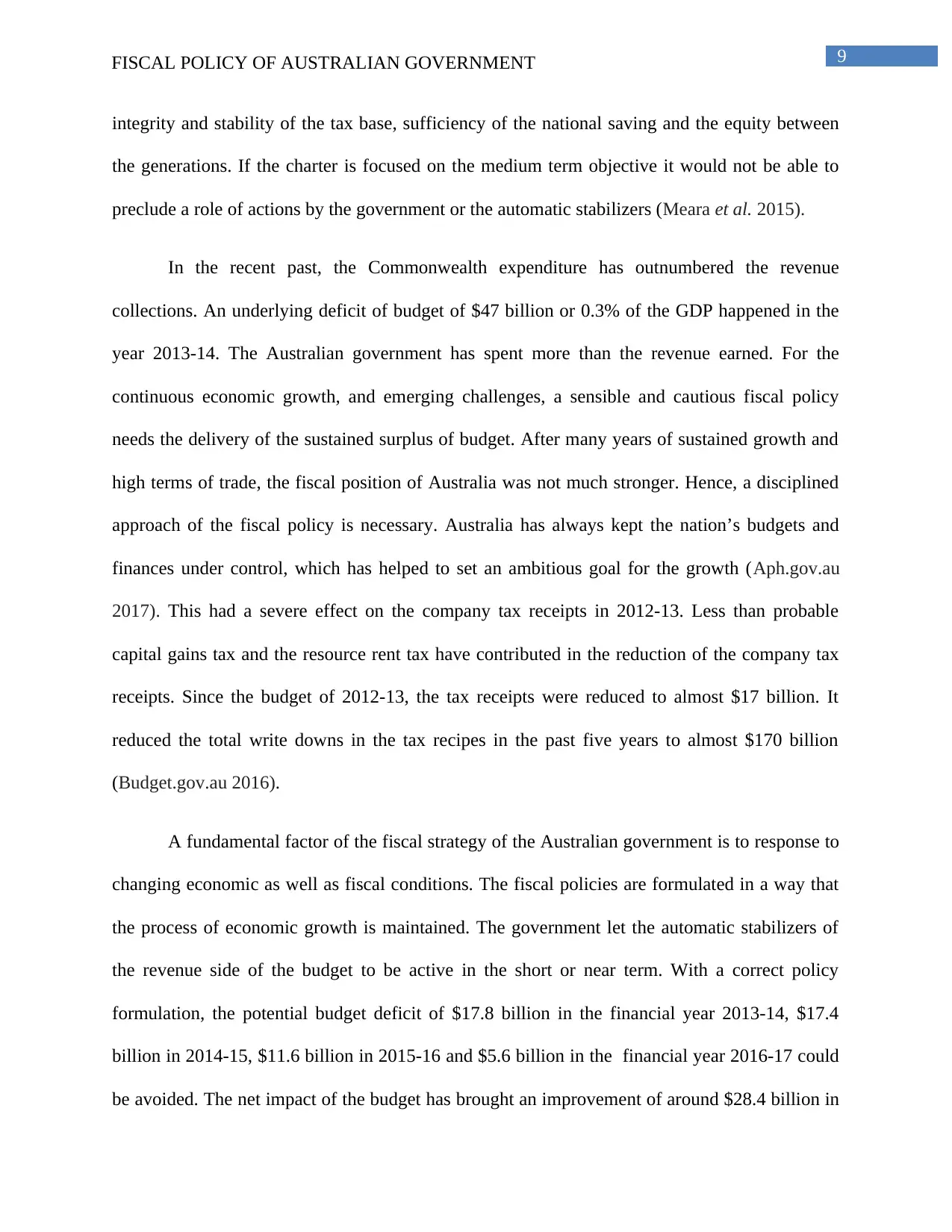
9FISCAL POLICY OF AUSTRALIAN GOVERNMENT
integrity and stability of the tax base, sufficiency of the national saving and the equity between
the generations. If the charter is focused on the medium term objective it would not be able to
preclude a role of actions by the government or the automatic stabilizers (Meara et al. 2015).
In the recent past, the Commonwealth expenditure has outnumbered the revenue
collections. An underlying deficit of budget of $47 billion or 0.3% of the GDP happened in the
year 2013-14. The Australian government has spent more than the revenue earned. For the
continuous economic growth, and emerging challenges, a sensible and cautious fiscal policy
needs the delivery of the sustained surplus of budget. After many years of sustained growth and
high terms of trade, the fiscal position of Australia was not much stronger. Hence, a disciplined
approach of the fiscal policy is necessary. Australia has always kept the nation’s budgets and
finances under control, which has helped to set an ambitious goal for the growth (Aph.gov.au
2017). This had a severe effect on the company tax receipts in 2012-13. Less than probable
capital gains tax and the resource rent tax have contributed in the reduction of the company tax
receipts. Since the budget of 2012-13, the tax receipts were reduced to almost $17 billion. It
reduced the total write downs in the tax recipes in the past five years to almost $170 billion
(Budget.gov.au 2016).
A fundamental factor of the fiscal strategy of the Australian government is to response to
changing economic as well as fiscal conditions. The fiscal policies are formulated in a way that
the process of economic growth is maintained. The government let the automatic stabilizers of
the revenue side of the budget to be active in the short or near term. With a correct policy
formulation, the potential budget deficit of $17.8 billion in the financial year 2013-14, $17.4
billion in 2014-15, $11.6 billion in 2015-16 and $5.6 billion in the financial year 2016-17 could
be avoided. The net impact of the budget has brought an improvement of around $28.4 billion in
integrity and stability of the tax base, sufficiency of the national saving and the equity between
the generations. If the charter is focused on the medium term objective it would not be able to
preclude a role of actions by the government or the automatic stabilizers (Meara et al. 2015).
In the recent past, the Commonwealth expenditure has outnumbered the revenue
collections. An underlying deficit of budget of $47 billion or 0.3% of the GDP happened in the
year 2013-14. The Australian government has spent more than the revenue earned. For the
continuous economic growth, and emerging challenges, a sensible and cautious fiscal policy
needs the delivery of the sustained surplus of budget. After many years of sustained growth and
high terms of trade, the fiscal position of Australia was not much stronger. Hence, a disciplined
approach of the fiscal policy is necessary. Australia has always kept the nation’s budgets and
finances under control, which has helped to set an ambitious goal for the growth (Aph.gov.au
2017). This had a severe effect on the company tax receipts in 2012-13. Less than probable
capital gains tax and the resource rent tax have contributed in the reduction of the company tax
receipts. Since the budget of 2012-13, the tax receipts were reduced to almost $17 billion. It
reduced the total write downs in the tax recipes in the past five years to almost $170 billion
(Budget.gov.au 2016).
A fundamental factor of the fiscal strategy of the Australian government is to response to
changing economic as well as fiscal conditions. The fiscal policies are formulated in a way that
the process of economic growth is maintained. The government let the automatic stabilizers of
the revenue side of the budget to be active in the short or near term. With a correct policy
formulation, the potential budget deficit of $17.8 billion in the financial year 2013-14, $17.4
billion in 2014-15, $11.6 billion in 2015-16 and $5.6 billion in the financial year 2016-17 could
be avoided. The net impact of the budget has brought an improvement of around $28.4 billion in
Paraphrase This Document
Need a fresh take? Get an instant paraphrase of this document with our AI Paraphraser
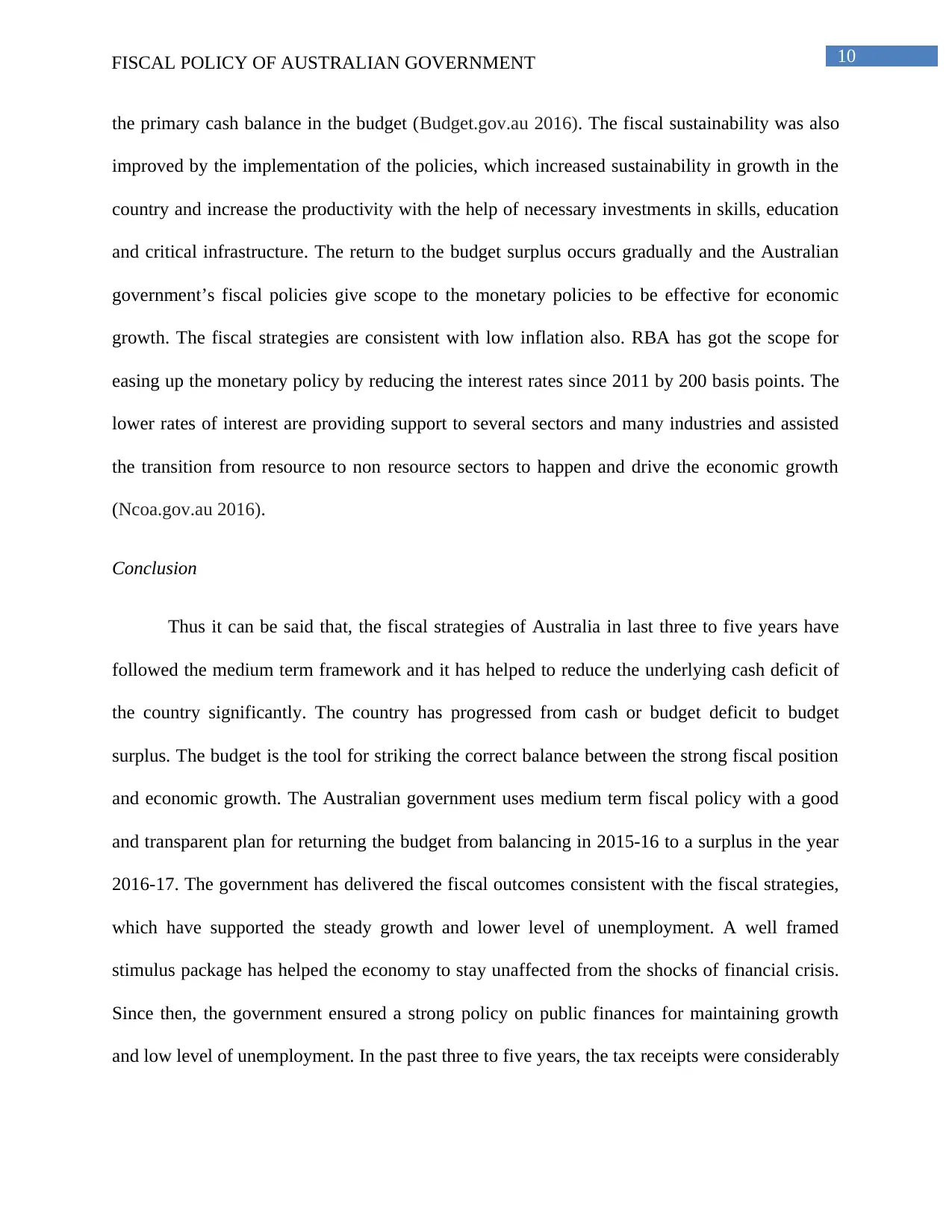
10FISCAL POLICY OF AUSTRALIAN GOVERNMENT
the primary cash balance in the budget (Budget.gov.au 2016). The fiscal sustainability was also
improved by the implementation of the policies, which increased sustainability in growth in the
country and increase the productivity with the help of necessary investments in skills, education
and critical infrastructure. The return to the budget surplus occurs gradually and the Australian
government’s fiscal policies give scope to the monetary policies to be effective for economic
growth. The fiscal strategies are consistent with low inflation also. RBA has got the scope for
easing up the monetary policy by reducing the interest rates since 2011 by 200 basis points. The
lower rates of interest are providing support to several sectors and many industries and assisted
the transition from resource to non resource sectors to happen and drive the economic growth
(Ncoa.gov.au 2016).
Conclusion
Thus it can be said that, the fiscal strategies of Australia in last three to five years have
followed the medium term framework and it has helped to reduce the underlying cash deficit of
the country significantly. The country has progressed from cash or budget deficit to budget
surplus. The budget is the tool for striking the correct balance between the strong fiscal position
and economic growth. The Australian government uses medium term fiscal policy with a good
and transparent plan for returning the budget from balancing in 2015-16 to a surplus in the year
2016-17. The government has delivered the fiscal outcomes consistent with the fiscal strategies,
which have supported the steady growth and lower level of unemployment. A well framed
stimulus package has helped the economy to stay unaffected from the shocks of financial crisis.
Since then, the government ensured a strong policy on public finances for maintaining growth
and low level of unemployment. In the past three to five years, the tax receipts were considerably
the primary cash balance in the budget (Budget.gov.au 2016). The fiscal sustainability was also
improved by the implementation of the policies, which increased sustainability in growth in the
country and increase the productivity with the help of necessary investments in skills, education
and critical infrastructure. The return to the budget surplus occurs gradually and the Australian
government’s fiscal policies give scope to the monetary policies to be effective for economic
growth. The fiscal strategies are consistent with low inflation also. RBA has got the scope for
easing up the monetary policy by reducing the interest rates since 2011 by 200 basis points. The
lower rates of interest are providing support to several sectors and many industries and assisted
the transition from resource to non resource sectors to happen and drive the economic growth
(Ncoa.gov.au 2016).
Conclusion
Thus it can be said that, the fiscal strategies of Australia in last three to five years have
followed the medium term framework and it has helped to reduce the underlying cash deficit of
the country significantly. The country has progressed from cash or budget deficit to budget
surplus. The budget is the tool for striking the correct balance between the strong fiscal position
and economic growth. The Australian government uses medium term fiscal policy with a good
and transparent plan for returning the budget from balancing in 2015-16 to a surplus in the year
2016-17. The government has delivered the fiscal outcomes consistent with the fiscal strategies,
which have supported the steady growth and lower level of unemployment. A well framed
stimulus package has helped the economy to stay unaffected from the shocks of financial crisis.
Since then, the government ensured a strong policy on public finances for maintaining growth
and low level of unemployment. In the past three to five years, the tax receipts were considerably

11FISCAL POLICY OF AUSTRALIAN GOVERNMENT
affected by weaker nominal GDP growth. The high AUD and weak commodity prices have
lowered the profits of the organizations in all sectors.
References
Aghion, P., Hemous, D. and Kharroubi, E., 2014. Cyclical fiscal policy, credit constraints, and
industry growth. Journal of Monetary Economics, 62, pp.41-58.
Aph.gov.au, 2017. The tools of macroeconomic policy—a short primer. [online] Aph.gov.au.
Available at:
http://www.aph.gov.au/About_Parliament/Parliamentary_Departments/Parliamentary_Library/
pubs/BriefingBook44p/MacroeconomicPolicy [Accessed 22 Sep. 2017].
Argy, V.E. and Nevile, J. eds., 2016. Inflation and Unemployment: Theory, Experience and
Policy Making. Routledge.
Arrow, K.J. and Kruz, M., 2013. Public investment, the rate of return, and optimal fiscal
policy (Vol. 1). Routledge.
Borcherding, T.E. and Keynes, J.M., 2015. Cameron M. Weber See also: Fiscal Balance;
Monetary Policy; Public Works Policy; Stimulus Package, US (2008); Stimulus Package, US
(2009); Tax Policy. Booms and Busts: An Encyclopedia of Economic History from the First
Stock Market Crash of 1792 to the Current Global Economic Crisis, p.276.
Budget.gov.au, 2016. Budget 2016-17 - Budget Paper No.1 - Statement 3: Fiscal Strategy and
Outlook - Fiscal Strategy. [online] Budget.gov.au. Available at: http://www.budget.gov.au/2016-
17/content/bp1/html/bp1_bs3-01.htm [Accessed 22 Sep. 2017].
affected by weaker nominal GDP growth. The high AUD and weak commodity prices have
lowered the profits of the organizations in all sectors.
References
Aghion, P., Hemous, D. and Kharroubi, E., 2014. Cyclical fiscal policy, credit constraints, and
industry growth. Journal of Monetary Economics, 62, pp.41-58.
Aph.gov.au, 2017. The tools of macroeconomic policy—a short primer. [online] Aph.gov.au.
Available at:
http://www.aph.gov.au/About_Parliament/Parliamentary_Departments/Parliamentary_Library/
pubs/BriefingBook44p/MacroeconomicPolicy [Accessed 22 Sep. 2017].
Argy, V.E. and Nevile, J. eds., 2016. Inflation and Unemployment: Theory, Experience and
Policy Making. Routledge.
Arrow, K.J. and Kruz, M., 2013. Public investment, the rate of return, and optimal fiscal
policy (Vol. 1). Routledge.
Borcherding, T.E. and Keynes, J.M., 2015. Cameron M. Weber See also: Fiscal Balance;
Monetary Policy; Public Works Policy; Stimulus Package, US (2008); Stimulus Package, US
(2009); Tax Policy. Booms and Busts: An Encyclopedia of Economic History from the First
Stock Market Crash of 1792 to the Current Global Economic Crisis, p.276.
Budget.gov.au, 2016. Budget 2016-17 - Budget Paper No.1 - Statement 3: Fiscal Strategy and
Outlook - Fiscal Strategy. [online] Budget.gov.au. Available at: http://www.budget.gov.au/2016-
17/content/bp1/html/bp1_bs3-01.htm [Accessed 22 Sep. 2017].
⊘ This is a preview!⊘
Do you want full access?
Subscribe today to unlock all pages.

Trusted by 1+ million students worldwide
1 out of 15
Related Documents
Your All-in-One AI-Powered Toolkit for Academic Success.
+13062052269
info@desklib.com
Available 24*7 on WhatsApp / Email
![[object Object]](/_next/static/media/star-bottom.7253800d.svg)
Unlock your academic potential
Copyright © 2020–2025 A2Z Services. All Rights Reserved. Developed and managed by ZUCOL.





